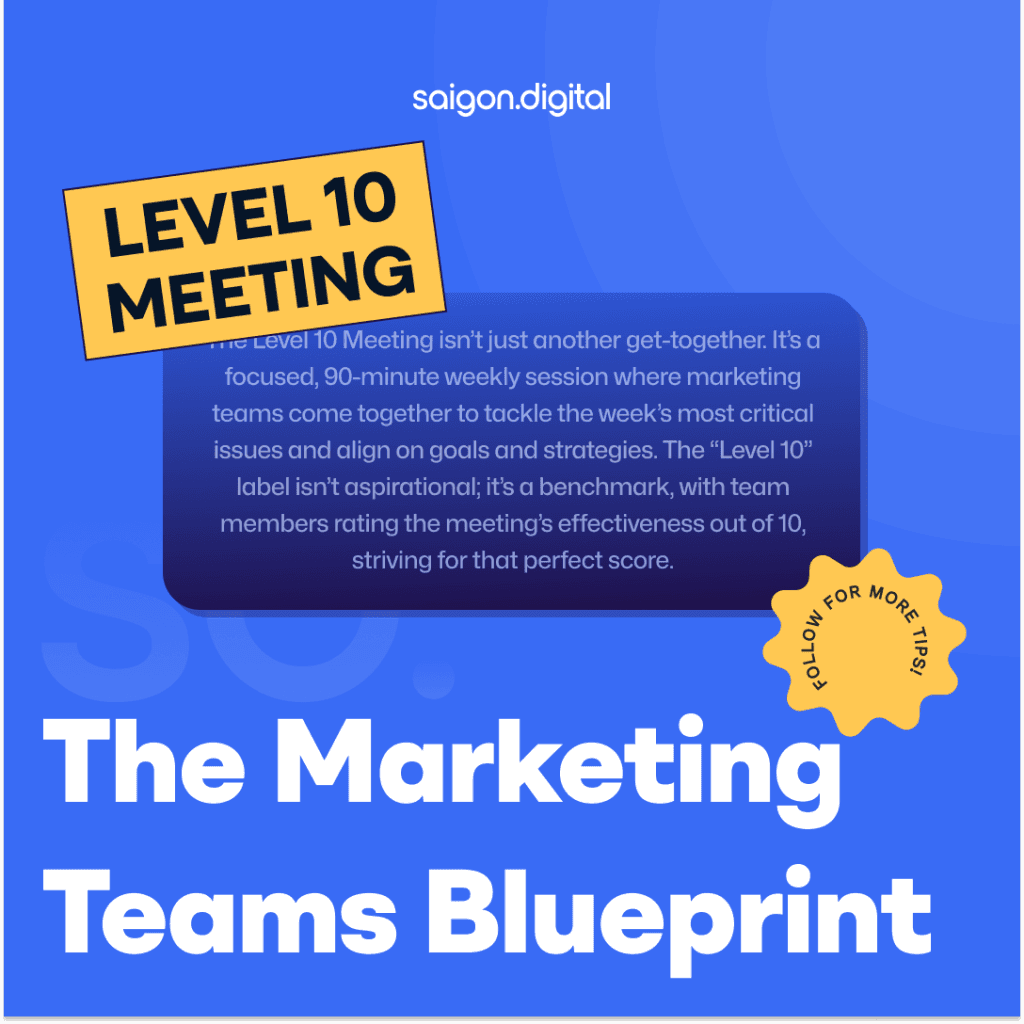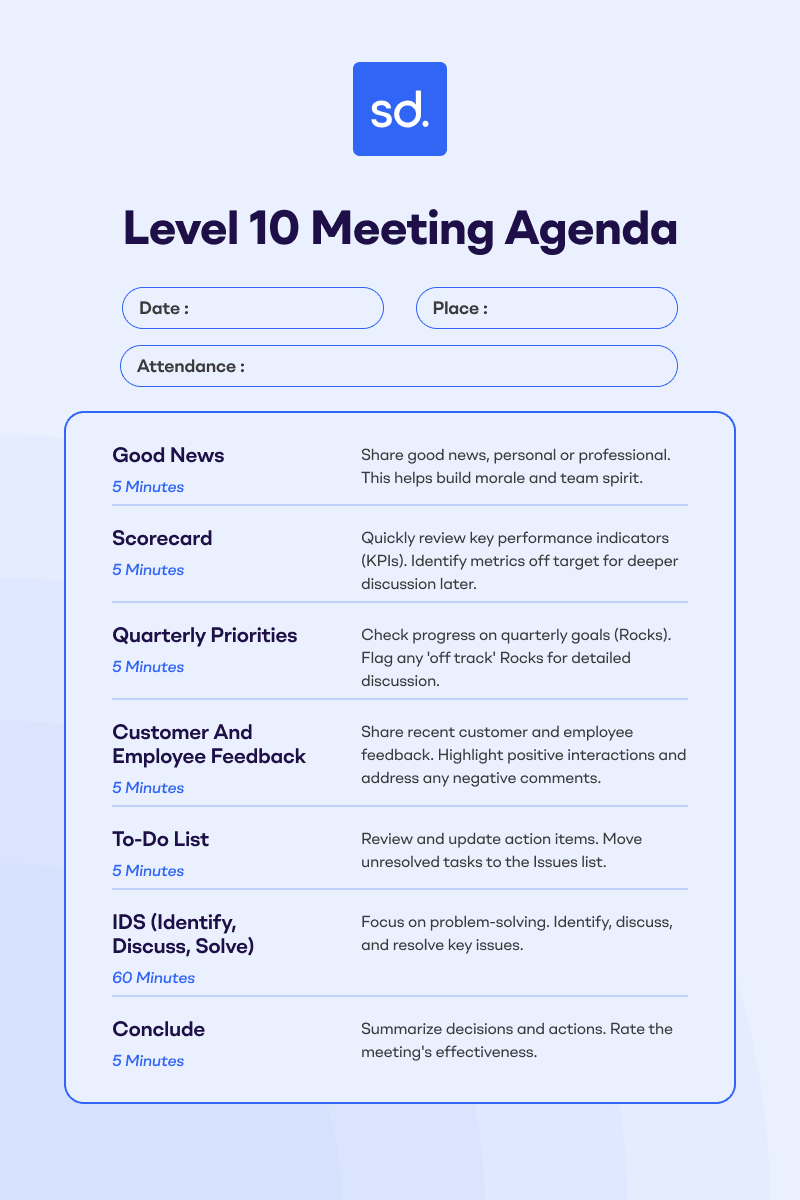
Stick with us, and we’ll walk you through how these meetings have sharpened our ideas and strategies, making every Monday feel like the start of a winning streak.
What is a Level 10 Meeting?
A Level 10 Meeting isn’t your average team huddle. It’s a tightly structured, 90-minute weekly session where marketing teams come together to tackle their biggest challenges head-on.
The name isn’t just a lofty ambition; it’s a target score. Every meeting is rated out of ten, and the aim is always perfection.
The Origins of Level 10 Meetings
Entrepreneurial Operating System (EOS), a firm specialising in business improvement, developed the concept. They found that most leaders rated their meetings a dismal four out of ten – hardly a glowing report card. So, they created a new approach that guarantees top marks every time.
The EOS Level 10 Meeting Format
The secret sauce? Consistency. A Level 10 Meeting follows the same script every week. It starts with a quick check-in, then reviews the team’s overall performance before diving into the three most pressing issues. Each section has a strict time limit to keep things on track.
This rigid format ensures everyone knows what to expect and comes prepared. Meetings start and finish on the dot, no excuses. Everyone rates the session at the end, highlighting what worked and what didn’t. It's a constant drive for improvement.
To sum up, an EOS Level 10 Meeting is all about:- Consistency:Same time, same place, same agenda every week.
- Focus: Tackling the three most critical issues.
- Accountability: Everyone rates the meeting and suggests improvements.
Level 10 Meetings: Benefits And Limits For Marketing Team
Marketing is a whirlwind of activity, brimming with tasks, ideas, and challenges. Level 10 Meetings offer a structured approach to navigating this chaos, ensuring your team stays focused, aligned, and ahead of the game. Whether you're tracking KPIs or brainstorming solutions, these meetings keep you productive rather than just busy.
The Upsides
- Time Efficiency: Level 10 Meetings are strictly timed, meaning everyone gets in, gets the job done, and gets back to their other responsibilities.
- Goal Orientation: By focusing on the three most pressing issues, these meetings keep your team laser-focused on what really matters, helping you achieve your objectives faster.
- Problem-Solving Powerhouse: Unlike post-mortem meetings that dwell on past performance, Level 10 Meetings are all about finding solutions. It's a no-nonsense approach to tackling challenges head-on.
The Downsides
- Limited Discussion: To keep the meeting on track, there's little room for tangents or in-depth discussions about side issues. This could stifle some creative thinking.
- Preparation Time: To make the most of a Level 10 Meeting, everyone needs to come prepared. This extra workload can add to your overall workload.
The Level 10 Marketing Meeting Agenda?
The Level 10 MeetingAgenda is a masterclass in meeting efficiency, designed to maximise the utility of every minute spent in the conference room—or on an online meeting.- Good News (5 minutes): We begin on an upbeat note, sharing personal and professional wins. This sets a positive tone and strengthens team morale.
- Scorecard Review (5 minutes): Quick-fire updates on key marketing metrics provide a snapshot of our performance against our goals.
- Quarterly Priorities Review (5 minutes): We assess the status of our quarter-long initiatives, ensuring they’re on the right track.
- Customer Headlines (5 minutes): Sharing feedback from our clients gives us direct insights into their experiences and our service's impact.
- To-Do List Review (5 minutes): Accountability is key; we review and tick off actions completed since our last gathering.
- Identify, Discuss, and Solve (IDS) (30 to 60 minutes): Here lies the crux of the meeting. We tackle pressing issues with a systematic approach, identifying the root cause, discussing potential solutions, and agreeing on actions.
- Conclude (5 minutes): We wrap up by recapping decisions, assigning tasks, and sharing a closing word to gauge the session's effectiveness.

Detailing the Level 10 Meeting Agenda?
1. Good News Segment(5 Minutes)
This opening act sets a positive tone for the meeting. Participants should share one piece of good news from their professional or personal lives. This practice not only begins the meeting on an uplifting note but also helps to humanise team members, reminding everyone that while work is essential, it’s not the entirety of one’s identity.
2. Scorecard Review (5 Minutes)
In this quick-fire round, each metric is assessed succinctly. The team swiftly reviews a set of predefined metrics that reflect the health of the marketing department. These could range from lead generation numbers to social media engagement rates. Members responsible for each metric report whether they're on target, with no deep dives at this stage—any off-target metrics get queued for the IDS session.
3. Quarterly Priorities Review (5 Minutes)
This step is a check-in on the progress of the quarterly goals, also known as 'Rocks'. These are the significant milestones that align with the overarching objectives of the department and the company. Each Rock owner updates the group with a simple ‘on track’ or ‘off track’ status. We will tag the 'Rocks' that are off track for in-depth analysis in the IDS phase.
4. Customer and Employee Headlines (5 Minutes)
In this segment, team members brief the group on notable interactions or feedback from customers and employees over the past week. This could include exceptional praise, critical feedback, or any other significant occurrence that needs to be on the team’s radar. It’s a pulse check on external and internal perceptions and experiences.
5. To-Do Lists (5 Minutes)
The focus here is on immediate, actionable items that have been set in previous meetings. The facilitator reviews the list, and team members acknowledge completed tasks. Any unfinished items are either deferred or moved to the Issues List if they need more attention. This part of the EOS meeting reinforces accountability and keeps the team on track with their week-to-week responsibilities.
6. IDS: Identify, Discuss, Solve (60 Minutes)
Here lies the crux of the Level 10 Meeting. The team moves into problem-solving mode, tackling each issue identified earlier in the meeting in order of priority. Each issue is thoroughly dissected to get to the root cause, and solutions are debated and decided upon. It's a collaborative effort to ensure that resolving the most critical problems are, paving the way for smooth operations and strategic advancement.7. Conclude (5 Minutes)
As the meeting draws to a close, a review of decisions and assigned actions ensures everyone is clear on their responsibilities. The group also agrees on any key messages that need to be communicated to wider teams. Finally, each member rates the meeting from one to ten to gauge its effectiveness and to continually improve the process for future meetings.
Q&A about Level 10 Marketing Meetings
1. Why is it called a Level 10 Meeting?
The Level 10 Meeting gets its name from a simple but powerful idea. At the end of every meeting, everyone rates it out of ten. It's a blunt way to gauge how effective the session was.
2. How long should a Level 10 Meeting last?
A Level 10 Meeting is strictly 90 minutes long, balancing thoroughness with respect for the team's time.
3. What does IDS stand for?
IDS stands for Identify, Discuss, and Solve – a tripartite approach to tackling issues effectively.
4. How many people should attend a Level 10 Meeting?
Ideally, keep the group to seven people or fewer to ensure everyone contributes and the meeting stays focused.
5. Where does the term Level 10 Meeting come from?
It originates from the EOS toolkit, a business framework that emphasises execution and operational excellence.





